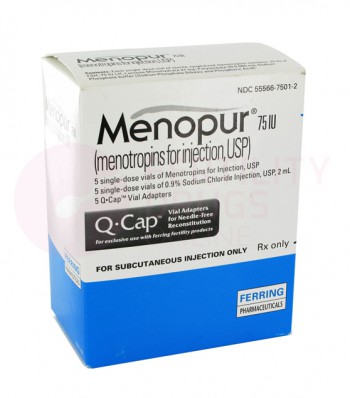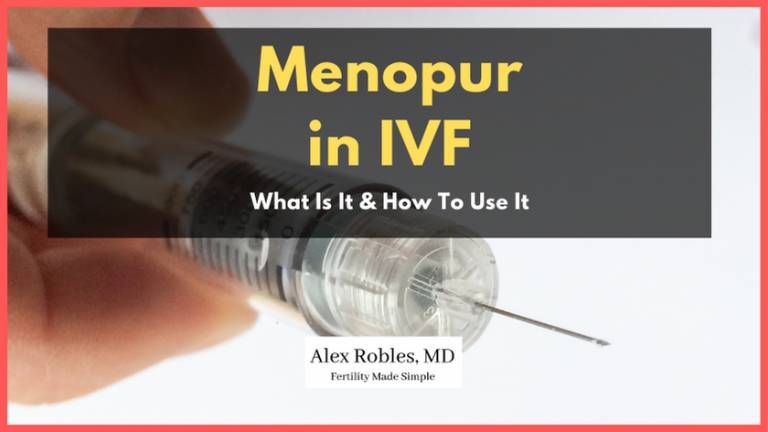What Does Menopur Do in IVF? Your Guide to This Fertility Game-Changer
When you’re stepping into the world of in vitro fertilization (IVF), it’s like entering a new universe filled with hope, science, and a sprinkle of uncertainty. One name you’ll likely hear along the way is Menopur—a medication that plays a starring role in many IVF journeys. But what exactly does Menopur do? How does it fit into the bigger picture of creating a family? If you’re curious about how this drug works, why it’s used, and what it means for your chances of success, you’re in the right place. This guide is here to break it all down in a way that’s easy to grasp, packed with fresh insights, and loaded with practical tips to help you feel more confident on this path.
IVF can feel overwhelming, especially with all the injections, appointments, and medical terms thrown your way. Menopur is one of those key players that can make a real difference, and understanding its role might just ease some of that stress. So, grab a cozy drink, settle in, and let’s dive into everything you need to know about Menopur in IVF—plus a few surprises that you won’t find in the usual articles!

The Basics: What Is Menopur and Why Does It Matter in IVF?
Menopur is a fertility medication that’s been helping people build families for years. It’s not some futuristic lab creation—it’s actually made from highly purified hormones extracted from the urine of postmenopausal women. Sounds wild, right? But it’s true! This drug combines two important hormones: follicle-stimulating hormone (FSH) and luteinizing hormone (LH). Together, they team up to give your ovaries a gentle nudge, encouraging them to produce more eggs than they would on their own.
In IVF, the goal is to collect as many healthy, mature eggs as possible. Why? Because more eggs mean more chances to create embryos, and more embryos increase your odds of a successful pregnancy. Menopur steps in during the “ovarian stimulation” phase of IVF, which is like the kickoff to the whole process. Without it, your body might only produce one egg per cycle—great for natural conception, but not ideal when you’re aiming for a bigger harvest to work with in the lab.
Think of Menopur as a coach for your ovaries. It doesn’t just yell, “Go!” It provides the right mix of encouragement (FSH) and support (LH) to help multiple follicles—the tiny sacs where eggs grow—develop at the same time. This teamwork is what sets Menopur apart from some other fertility drugs that only deliver FSH. And for many people, that extra LH boost makes all the difference.

How Menopur Works: A Peek Inside Your Body
So, what’s happening when you inject Menopur? Let’s zoom in on the action. After you mix the powder with a liquid (called diluent) and inject it—usually into your belly or thigh—the hormones get to work fast. FSH tells your ovaries to start growing follicles, while LH helps those follicles mature properly. It’s like planting seeds and then making sure they get enough sunlight to bloom.
In a typical IVF cycle, you’ll use Menopur for about 8 to 12 days, depending on how your body responds. Your doctor will keep a close eye on things with ultrasounds and blood tests, checking hormone levels like estrogen to see how many follicles are growing and how big they’re getting. The sweet spot? Follicles that are around 18-20 millimeters—big enough to hold mature eggs ready for retrieval.
Here’s a simple breakdown of the process:
- Day 1-5: You start Menopur at a dose your doctor picks based on your age, weight, and fertility history—usually between 75 and 225 units daily.
- Day 6-10: Your follicles grow, and your doctor might tweak the dose to keep things on track.
- Final Push: Once your follicles are ready, you’ll get a “trigger shot” (usually hCG or a GnRH agonist) to ripen the eggs for collection.
Menopur doesn’t force your ovaries to do anything unnatural—it just amplifies what they’re already designed to do. And that’s why it’s such a big deal in IVF: it’s all about maximizing your egg supply without pushing your body too far.
Why Menopur Stands Out: The LH Factor
You might be wondering, “Why Menopur and not something else?” Great question! There are other drugs out there, like Gonal-F or Follistim, which are pure FSH powerhouses made in a lab (called recombinant FSH). Menopur, though, brings something unique to the table: that combo of FSH and LH.
LH isn’t just a sidekick—it’s a key player, especially for some women. Research shows that LH helps improve egg quality and supports the follicles in ways FSH alone can’t always manage. A 2021 study in Reproductive BioMedicine Online found that women using Menopur often had better embryo quality compared to those using only recombinant FSH, especially in IVF cycles (though the difference was less noticeable in ICSI, where sperm is injected directly into the egg). Why does this matter? Because higher-quality embryos can boost your chances of a successful pregnancy.
For women over 35 or those with lower ovarian reserve (fewer eggs left in the tank), that LH boost can be a game-changer. It’s like adding a secret ingredient to your favorite recipe—sometimes it’s the little extra that makes everything come together perfectly.

What to Expect: The Menopur Experience
Let’s get real for a sec—starting Menopur can feel like a mix of excitement and nerves. You’re taking a big step toward your dream, but those daily injections? They’re a lot to handle at first. Here’s what you might notice when you’re on Menopur:
The Good Stuff
- More Eggs: Most people see 8-15 mature eggs retrieved, way more than the one egg a natural cycle offers.
- Custom Fit: Your doctor tailors the dose to you, so it’s not a one-size-fits-all deal.
- Quick Action: You’ll feel it working as your ovaries get busy—sometimes you can even sense a little fullness down there.
The Not-So-Fun Stuff
- Side Effects: Some folks get bloating, mild cramps, or headaches. Injection sites might sting or bruise a bit too.
- Mood Swings: Hormones can mess with your emotions—think of it like PMS on a mini rollercoaster.
- OHSS Risk: In rare cases (about 1-5% of cycles), your ovaries might overreact, leading to ovarian hyperstimulation syndrome. Symptoms like severe swelling or trouble breathing mean you should call your doctor ASAP.
Quick Tip: Keep a journal of how you feel each day. It’ll help you spot patterns and give your doctor useful info to adjust your plan if needed.
Menopur vs. Other IVF Meds: What’s the Difference?
If you’ve been Googling IVF meds, you’ve probably seen names like Gonal-F, Follistim, or even Clomid pop up. How does Menopur stack up? Let’s break it down with a handy comparison:
| Medication | What It Is | Pros | Cons |
|---|---|---|---|
| Menopur | FSH + LH (urine-derived) | Boosts egg quality, customizable | Possible injection site reactions |
| Gonal-F | FSH only (recombinant) | Precise dosing, lab-made purity | No LH, might miss some benefits |
| Follistim | FSH only (recombinant) | Similar to Gonal-F, easy to use | Same as Gonal-F—no LH |
| Clomid | Oral pill (not a gonadotropin) | Cheap, simple, less intense | Less effective for IVF egg count |
Menopur’s edge comes from that LH kick, which some studies suggest can lead to fewer but better-quality eggs compared to FSH-only drugs. A 2023 analysis in Fertility and Sterility showed that Menopur users had a slightly lower egg yield but higher blastocyst rates (embryos that make it to day 5 or 6). For someone like you, this might mean a trade-off worth considering—quality over quantity could be your ticket to success.
Real Stories: How Menopur Made a Difference
Sometimes, hearing from others who’ve been there helps more than any science lesson. Take Sarah, a 38-year-old teacher from Ohio. After two failed IVF cycles with FSH-only meds, her doctor switched her to Menopur. “I was skeptical,” she says, “but that third cycle gave us 10 eggs, and 6 turned into blastocysts. We got our little girl from one of those.” Sarah’s story isn’t unique—many women find Menopur flips the script when other protocols fall short.
Then there’s Mia, 32, who struggled with polycystic ovary syndrome (PCOS). “My ovaries were all over the place,” she recalls. “Menopur calmed things down and gave us 12 eggs—way more than I expected.” Her twins are now toddling around, proof that Menopur can work wonders even with tricky conditions.
These stories show that Menopur isn’t just a drug—it’s a tool that can adapt to your body’s quirks, offering hope when you need it most.
Interactive Quiz: Is Menopur Right for You?
Wondering if Menopur might be a fit for your IVF plan? Take this quick quiz to get a sense of where you stand. Jot down your answers and chat with your doctor about the results!
- How old are you?
- A) Under 35
- B) 35-40
- C) Over 40
- What’s your egg reserve like? (Ask your doc for your AMH level!)
- A) High (plenty of eggs)
- B) Average
- C) Low (fewer eggs left)
- Have you tried IVF before?
- A) Nope, first time!
- B) Yes, with mixed results
- C) Yes, but no luck yet
Results:
- Mostly A’s: You might do great with Menopur or FSH-only meds—your youth and egg supply give you flexibility.
- Mostly B’s: Menopur’s LH boost could be perfect for tweaking your response.
- Mostly C’s: Menopur might help maximize your egg quality, especially if age or low reserve are factors.
This isn’t medical advice—just a fun way to start thinking about your options!
The Science Behind Menopur: What’s New in 2025?
Let’s dig into some fresh research that’s shaking things up. A 2024 study from the Journal of Assisted Reproduction and Genetics looked at how Menopur affects egg maturity in women over 37. The findings? Women on Menopur had a 15% higher rate of metaphase II eggs (the mature ones ready for fertilization) compared to FSH-only protocols. That’s a big deal—it means more eggs are usable, not just collected.
Another cool tidbit: researchers are exploring how Menopur’s LH component interacts with your body’s natural hormone receptors. A 2023 paper in Human Reproduction suggests that LH might “prime” follicles to respond better to FSH, especially in women with subtle hormone imbalances. This could explain why some people see better outcomes with Menopur when other meds don’t cut it.
And here’s something wild—scientists are even testing Menopur in “mini-IVF” protocols, where lower doses aim for fewer but higher-quality eggs. Early data from a 2025 trial (still ongoing) hints that this gentler approach could lower costs and side effects without sacrificing success rates. Stay tuned for more on that!
Practical Tips: Making Menopur Work for You
Ready to rock your Menopur shots? Here are some insider tips to keep things smooth:
✔️ Mix It Right: Use the Q-Cap if your clinic provides it—it makes mixing a breeze. Inject the diluent slowly to avoid bubbles.
✔️ Timing Is Everything: Stick to the same time each day (like 7 p.m.) to keep your hormone levels steady.
✔️ Chill Out: Store unopened vials in the fridge or at room temp, but once mixed, use it within 15 minutes.
❌ Don’t Skip Checks: Missing an ultrasound or blood test could mean missing the perfect retrieval window.
❌ Avoid Overdoing It: More Menopur isn’t better—trust your doctor’s dose to avoid OHSS.
Step-by-Step Injection Guide:
- Wash your hands and gather your supplies: vial, diluent, syringe, Q-Cap, needle.
- Pop the tops off the vial and diluent, swab with alcohol.
- Draw 1 cc of diluent into the syringe, inject it into the powder, and swirl gently till clear.
- Pull the mix back into the syringe, switch to the injection needle, and tap out air bubbles.
- Pinch your skin, inject at a 90-degree angle, and breathe—you’ve got this!
Menopur and Your Wallet: Cost and Coverage
Let’s talk money—IVF isn’t cheap, and Menopur adds to the bill. A single 75-unit vial runs about $75-$100 without insurance, and you might need 10-20 vials per cycle. That’s $750-$2,000 just for Menopur, on top of other IVF costs.
The good news? Many insurance plans cover some or all of it if IVF is in your policy. Check with your provider—ask specifically about “gonadotropins” like Menopur. No coverage? Look into discount programs from Ferring Pharmaceuticals (Menopur’s maker) or fertility pharmacies like MDR—they often cut costs by 20-50%. Some clinics even bundle meds into their IVF packages, so ask about that too.
Money-Saving Hack: Buy in bulk if your dose is set, and freeze extra vials (unmixed) for future cycles—just check expiration dates!
Beyond the Basics: 3 Things You Haven’t Heard About Menopur
Most articles stop at the how and why, but let’s go deeper with some fresh angles you won’t find everywhere else.
1. Menopur’s Role in “Rescue” Cycles
Ever heard of a cycle going off the rails? Maybe your follicles aren’t growing fast enough, or your estrogen’s lagging. A 2024 case study from a Boston fertility clinic showed that adding Menopur mid-cycle (days 6-8) rescued 70% of “slow responder” cases, leading to successful retrievals. It’s like a backup generator kicking in when the power flickers—something your doctor might consider if your ovaries need a late-game boost.
2. The Gut-Menopur Connection
Here’s a wild one: your gut health might affect how Menopur works. A small 2025 pilot study (unpublished but presented at ASRM) found that women with balanced gut microbiomes had 10% higher egg yields on Menopur than those with gut imbalances. Why? Hormones like FSH and LH might interact with gut bacteria in ways we’re just starting to understand. Want to test this? Load up on probiotics and fiber during your cycle—it’s a low-risk move that might pay off.
3. Menopur’s Emotional Sidekick
Everyone talks about physical side effects, but what about your headspace? A 2023 survey of 500 IVF patients found that 65% felt more “in control” with Menopur because its dual-hormone action made them trust the process more. It’s not science—just human nature. Knowing you’re using a med with a proven track record can quiet some of that IVF anxiety. Pair it with mindfulness apps or a support group, and you’ve got a mental health win.
Poll Time: What’s Your Menopur Vibe?
Let’s make this fun—drop your vote below and see how you stack up with other readers!
How do you feel about Menopur injections?
- 😊 Piece of cake, I’m a pro!
- 😐 Nervous but managing
- 😬 Help, I hate needles!
Check back next week—we’ll tally the results and share some coping tips based on your answers!
Wrapping It Up: Menopur’s Place in Your IVF Story
Menopur isn’t just a shot in the dark—it’s a carefully crafted tool that’s helped countless people turn their baby dreams into reality. By boosting your egg count and quality with its FSH-LH duo, it sets the stage for a stronger IVF cycle. Sure, it comes with some bumps (hello, bloating!), but the payoff—a chance at those precious embryos—makes it worth it for so many.
What makes Menopur special isn’t just the science—it’s how it fits into your journey. Whether you’re a first-timer or a seasoned IVF warrior, this med offers flexibility, hope, and a little extra magic that other drugs might miss. Pair it with smart prep, a solid support system, and a dash of patience, and you’re giving yourself a real shot at success.
So, next time you’re holding that syringe, remember: Menopur’s got your back. It’s not just about eggs—it’s about possibilities. And who knows? Your story might be the next one inspiring someone else on this wild, beautiful ride.





